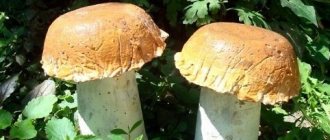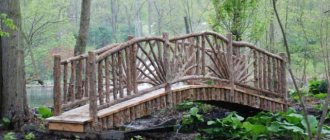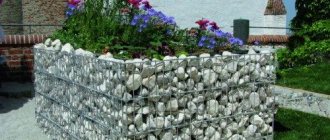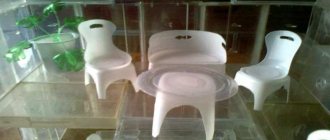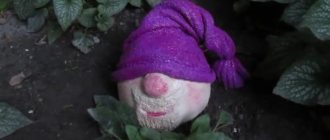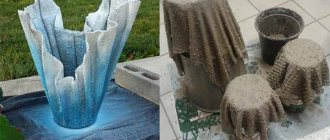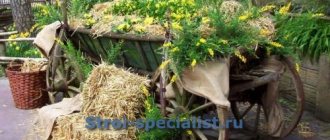Not every gardener knows such a word as rutarium. But in fact, this unique composition is very common in modern landscape design. When literally translated from English, “root” is a root; accordingly, rutarium is a composition of branches, snags, roots and even stumps. Previously, similar elements were included in the front garden, flower garden or rock garden to make them unusual. Today, from the simplest roots and branches of trees, you can create a rutarium with your own hands. Just a little desire, imagination and fantastic compositions will transform the entire appearance of the garden plot.
Rutaria
Rutarium can be the main component of design
When deciding to make an original composition on your site, you should take into account several nuances and tips. Thus, a rutary can act as an independent unit of landscape design, and be an auxiliary element in a complex composition. It is worth noting that in the first case, you will need to pay a lot of attention and involve professionals, and in the second, everything is quite simple, and any novice gardener can cope with the task.
Or auxiliary
The many advantages of rutaria should also include:
- creativity;
- ease of creation;
- availability of all materials;
- ease of care;
- guaranteed success.
There are several types of rutarii.
Natural rutarium
Natural. This is the main type of rutaria. You can create it at the dacha, including in the composition those materials that are on the territory. For example, an old tree that has been cut down can become the basis for a future root garden. Small flowers that are planted directly into the stump will look quite original. Stone and moss should be included as an addition, they are also easy to obtain.
Stumps instead of flowerpots
Protozoa. The composition includes exclusively driftwood and stumps. They will become a harmonious addition to an alpine hill or will find a place for themselves in a secluded corner of the garden.
Stump figures
Decorative. The most complex type, since its development and creation necessarily includes figures made of wood and various plants. Skilled craftsmen make fairy-tale characters and animals from unsightly driftwood. This will certainly require at least the advice of a professional, but as a result you can get something more than a simple set of roots.
Note!
Rutary is a universal element of landscape design, where there are no restrictions for creativity and imagination.
Filler greening process
Consider an example of planting a topiary in the shape of a lion:
- The first to be planted is the “lion skin”, which is planted with flowers;
- “Mane” - add lawn grass, which is decorated with long stems;
- Small details of the figure. Tail, ears, paws, muzzle;
- They make holes in the soil with a sharp object, sending seeds or already rooted plants into them;
- Seal the holes and cover with moss;
- It is advisable to install supports for each figure so that the structure does not collapse;
- Watering can be done either manually using a watering can or with a special irrigation system.
The process of choosing plants, various planting schemes - gives a wide scope for your imagination when making topiary. But do not forget that summer is not all year round, and in winter everything can perish if you do not take care of insulation. It will take a lot of effort and time to master such a skill, but the result is worth it.
Basic rules for creating a rutaria
It is impossible to say that there are strict rules when creating a composition, since it is impossible to plan exactly the final result. You should only adhere to the basic rule: the rutarium should, in its entire appearance, resemble a corner of wild nature. However, it is recommended to consider a few tips:
- Clear planning. It is best to record all your thoughts and wishes on paper or use special computer programs to develop landscape design.
- As mentioned above, rutarium can consist entirely of inanimate elements of wood or can be combined well with living flowers.
- When selecting roots and bark, special attention should be paid to those elements that resemble a fairy-tale character or figure.
- The placement of the composition has no restrictions. This could be a veranda, a front garden in front of the house, a garden, an artificial pond and other options.
Note!
It is impossible to create two identical rutaria, since nature is unique.
Progress of frame topiary
The job is not difficult to complete, but it will take a lot of time to complete. Let's describe the progress in detail:
Decide on the shape of the topiary; it should fit into the overall design of the garden and be practical.
Basic forms:
- geometric shapes (ball, pyramid, square, cube and others);
- fairy-tale heroes;
- figures of various animals and birds.
Create a metal frame for topiary from wire, preferably steel, fastened by welding or special ties.
Pour out the base, in this case chernozem with nutrients, adding a resinous substance for viscosity. Add water.
Secure with steel mesh to ensure that the structure is stable and the soil does not spill out. Spray water on the structure.
Add soil and water. The mixture should be viscous and not extend beyond the frame. Remove excess layers of soil with a trowel. Make sure that there are no gaps left, otherwise everything will fall apart.
Sow the soil with seeds. Combine flower seeds and herbs to create the best effect.
Determining the place
Choose a good place
The great popularity of rutarii is due to the fact that with their help you can transform and radically change the appearance of even the most problematic area in the garden area. If there is an original place that is not suitable for creating a front garden with perennial plants, then the root garden is the right place.
Another good option is a shady area under a spreading canopy of trees. When looking at your site, pay attention to the corners of the fence. Most likely, there is nothing here, since flowers will not grow due to the shadow. That is why the rutary will look win-win.
Note!
Rutarium is suitable for decorating a blind fence.
Execution options
Before starting to create this composition in the garden area, it is necessary to take into account the style concept of landscape design throughout the entire area. In simple terms, the rockery should correspond to the overall design scheme.
In turn, they are divided into the following types:
English. Plants for rock gardens are selected based on the color palette. For example, an excellent combination is thuja emerald, barberry thunberg, thuja occidentalis.
Ecological. Here they adhere to the most accurate imitation of the natural landscape. The finished composition leaves no doubt that it was created by nature, but not by a professional designer.
To do this, they adhere to the rockery scheme. In this case, ground cover types of vegetation, cereal grasses and dwarf shrubs are used.
Preparation
Collect stumps and snags
To know how to make a beautiful rutarium on your site, you need to start from the very beginning. So, the basis of the composition are ordinary branches and stumps, which should not be thrown away or burned. Store them in your shed and garage so you can use them later. If there is not enough material on the territory, you can go for a walk in the forest. There will certainly be an interesting snag or piece of bark here.
The basis of the composition can be an ordinary stump
It is very important to remember that wood is a fragile material, in addition, it will be influenced by various factors:
- the tree will begin to rot from excess moisture and direct contact with the ground;
- due to the high heat in the summer, driftwood will also dry out;
- vulnerable to insects.
Preference should be given to hard wood. A good option would be to choose driftwood and logs that were found on the beach of a river or lake.
Suitable driftwood found on river banks
It is worth paying attention to the preparation of the material, that is, wooden elements:
- remove bark from all elements so as not to attract bark beetles;
- treat the wood with special antiseptics that will protect it from the effects of precipitation;
- remove existing larvae and bacteria using boiling water and then dry;
- To extend the life of the rutaria, it is best to cover the elements with a layer of varnish or machine oil, which will also protect the wood from moisture and soil.
Remove bark and process
Note!
Among the tree varieties most susceptible to rot are aspen, poplar and birch, so it is better to minimize their presence in the tree.
Wood and stone processing
All wooden parts must be doused with boiling water to destroy the larvae in the cracks. Then the tree should be dried and treated with a composition against bark beetles and rotting. It is best to use colorless preparations so as not to spoil the natural appearance of the material. If we are talking about a composition in the center of which there is a stump, then the space around it will need to be cleared of weeds and debris, and the rot in the middle will need to be removed as much as possible. Do not touch the moss - this is a beautiful ground cover plant that looks good in a rutaria.
With stones the situation is simpler. It is enough to select them by size, wash them well and clean them of any remaining vegetation. You can cover them with paint or varnish and surround the central part of the composition with them. Or you can place figurines of fairy-tale characters on the stones, creating a play corner for children.
Composition design
When everything is prepared and planned, you can start arranging the elements. Stick to the plan you created. You should start with the largest elements - stumps and snags - which should take center stage. Bulky and tall elements must be securely fixed so that the wind cannot break the constructed composition.
Start with large elements
From large elements you can move on to medium ones, and then to the smallest ones. After everything is put in its place, evaluate the result. You can make adjustments if necessary. Follow the advice and wishes of those in your household, as well as your own intuitions. Only at the last stage can you start planting plants.
Note!
When planning to create a rutary, you must always remember that it belongs to the restrained style of landscape decor, which is characterized by Scandinavian rigor.
Fern
If you decide to include plants in the composition, then all selected plants should look like wild plants. It is worth abandoning tall and lush types, and give preference to:
- fern;
- moss;
- alpine herbs;
- daisies;
- begonias;
- petunias.
Almost all low-growing plants will fit harmoniously into a woody composition. Particular attention should be paid to the yaskolka, which designers quite often include in the compositions of rutaries. You can also place small decorative garden figures - mushrooms, snails, gnomes and animals.
Use low growing plants
Note!
The main attraction of landscape design is the illusion of untouched nature.
At the end of the article, I would like to remind you that rutaria, like any other landscape design composition, requires careful and special care. Despite all precautions and protection measures, some elements may begin to rot and deteriorate, so they should be replaced in a timely manner. Weeds may also appear among the plants, which will spoil the overall appearance - they must be removed.
Types of garden decor used for decoration
Garden arrangement depends on the general idea of arranging the local area and the style of design of the areas allocated for work and rest.
To improve the aesthetics of a certain area, a number of activities should be carried out that relate to planning and landscape design:
- dividing the territory into separate, functional zones;
- determining the boundaries of green spaces and the installation point of decor;
- selection of optimal solutions and decorations for the garden plot.
It should be remembered that to decorate the site, you can use functional and decorative decorations with different design styles.
Pros of rock garden
There are several advantages of rockeries in relation to alpine slides. These include:
On a flat relief you can quickly create a decorative composition. Building a rock garden will require a lot of time and additional financial investments.
To design a rock garden, you can use various types of decorative vegetation. To design a rock garden you will need certain crops that will help reveal all the beauty and grace of this landscape decoration.
Most often, the first type of decor is used to prevent erosion on the soil surface. The correct arrangement of stone blocks can reduce the weathering of the earthen substrate and its washout during climatic disasters.
What is the difference between a rock garden and an alpine slide?
Beginning gardeners often confuse a rock garden with an alpine slide. These compositions have some similarities in the choice of vegetation and method of design.
A common feature of these types of decorations is the use of a large number of stones and pebbles.
In addition, there are a number of distinctive features. They include:
Relief. An alpine hill is a rocky hill with a ridged peak. To decorate it, it uses a cascading arrangement of plants.
Illumination. A rockery requires sunny areas, while an alpine slide can be located in the shade or next to a hedge.
